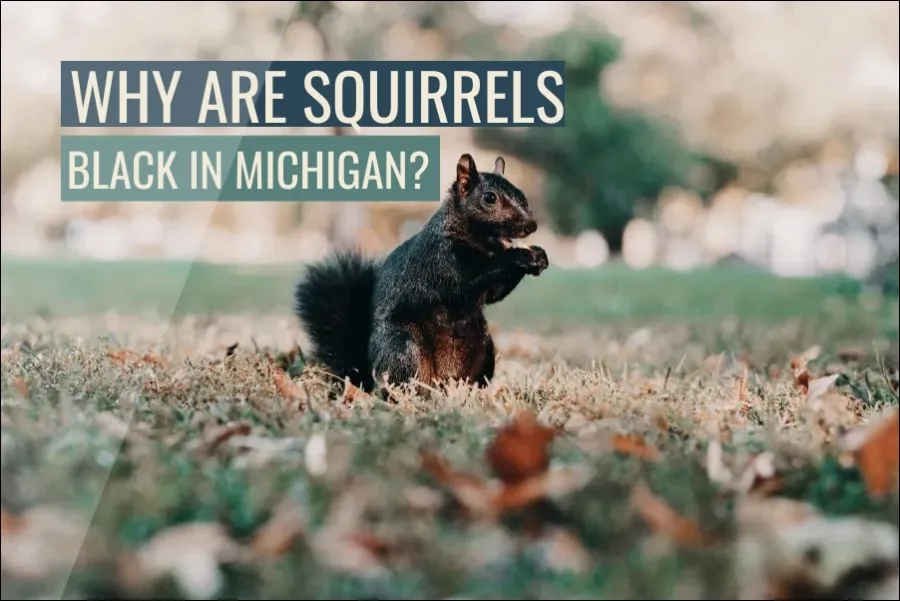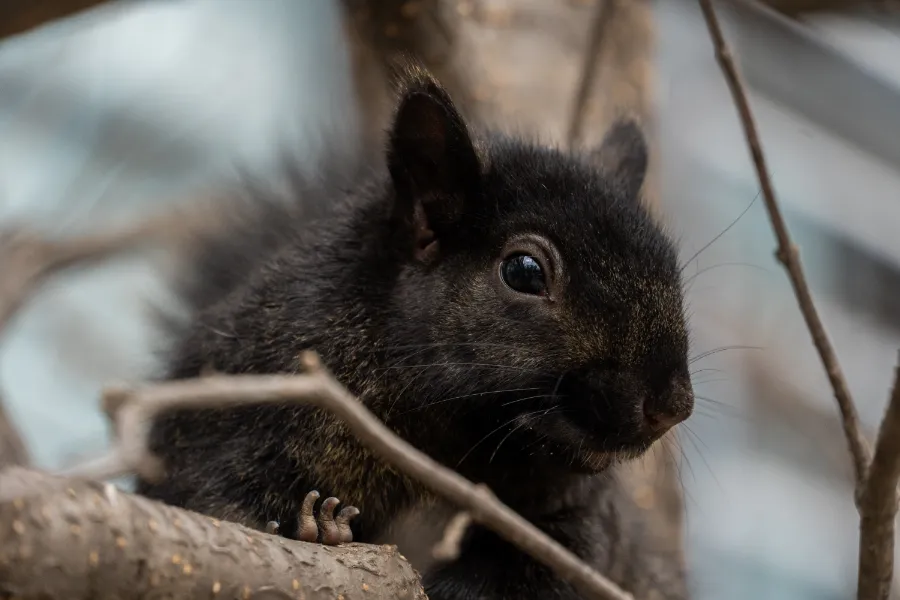
Squirrels are only one example of the diverse array of animal life that calls Michigan home. The vivid coats of these squirrels are sure to grab your attention. Many Michigan squirrels have black fur, despite the species’ more common gray or red. This begs the question, why are Michigan’s squirrels black?
The squirrels in Michigan are black due to a genetic trait called melanism, which results in the overproduction of eumelanin pigment. Black fur may provide a survival advantage to squirrels in certain environments, such as camouflage against predators and protection from the sun’s harmful UV rays.
The genetic reason behind squirrels’ black hair
Fur coloring is produced by melanins, which are made by specialized cells called melanocytes. The melanin eumelanin is responsible for producing darker hues like black and brown, whereas the melanin pheomelanin is responsible for producing brighter colors like red and yellow. Coloration is dictated by the melanocortin 1 receptor (MC1R) gene family. Involvement of these genes is essential for the generation and distribution of melanins throughout the body.
Squirrels have dark coats because of a genetic disease called melanism, which results in an overproduction of the eumelanin pigment. Depending on the animal’s family tree, melanin pigmentation can be inherited in a recessive pattern or as a dominant trait. Two copies of the melanistic allele (a variant version of a gene) that results in black fur are responsible for the common coloration of squirrels. In contrast, a squirrel that carries only one copy of the melanistic gene may have partially black and partially grey hair. Melanism may be affected by environmental factors such as temperature and UV radiation.
Melanism’s impact on Michigan’s squirrel population
You may spot both grey and black squirrels in Michigan, with the latter being more common in the western and northern parts of the state. Michigan’s squirrels are easily recognizable by their mostly black fur, which is the result of melanism. The high frequency of melanism in this group has been linked to a combination of genetic and environmental factors, but further study is needed to pinpoint the specific nature of these factors.
Some experts have theorized that melanism is an evolutionary advantage for squirrels so that they can better blend in with their environment under certain conditions. For example, squirrels could fare better if they had black fur since it would help them blend in with the ground and be less noticeable to predators. In addition to keeping it cool, the black fur may help protect it from the sun’s rays. Even though these hypotheses are fascinating, further research is needed to fully understand the role of melanism in Michigan’s squirrel population.

The presence of black squirrels in Michigan in the past
Since the early 1900s, black squirrels have been spotted in the state of Michigan. Most likely, black squirrels were brought to the United States from England by European immigrants and released into the wild. Ann Arbor and Ypsilanti, Michigan, were the first places where black squirrels were documented in the state of Michigan.
Black squirrels have quickly gained popularity and widespread recognition throughout Michigan since they were first spotted there. This has led to their proliferation across the state, where they may be seen inhabiting parks, gardens, and even backyard trees in urban and rural areas alike. Despite their great fame, not much is known about black squirrels in Michigan. Biological aspect of them needs more research.
The state’s geographic distribution of black squirrels.
The black squirrel has been reported from all around the state of Michigan, but it is most commonly observed in the southeast and southwest. Because to the abundance of green spaces, gardens, and suburban neighborhoods, black squirrels are frequently spotted by observers. Besides the UP and the UP of the LP of Michigan, you may also find these squirrels throughout the northern part of the LP. However, they are not uniformly distributed across the state; certain areas may see higher or lower occurrence rates.
Some areas of the state could have a higher incidence rate than others.
The patchy distribution of the black squirrel in Michigan can be attributed to a number of factors, including habitat, climate, and competition with other squirrel species. Black squirrels require a wide diversity of tree species and open spaces in their habitats for food and shelter. Because of their versatility, they are also widespread in the state’s urban and suburban regions.
Climate may have a factor in influencing the distribution of black squirrels due to the species’ temperature requirements. Even though the Upper Peninsula has harsh, snowy winters, black squirrels have been spotted in the state’s southern regions, where the weather is milder and wetter.
The cultural significance of black squirrels in Michigan
Squirrels of the black kind have become something of a state symbol in Michigan, beloved by both residents and visitors. They have inspired local artists and musicians, and their stories are frequently referenced in local literature. Black squirrels have become a popular mascot and emblem for schools, sports teams, and businesses across the state.
A staple of Michiganian life for so long and with such universal admiration, black squirrels are now considered a cultural icon. The unique beauty and allure of the Michigan landscape is appreciated and even admired by many. As symbols of Michigan’s rich biodiversity, black squirrels have been used in campaigns to promote the need of conserving our natural resources.
The environmental impact of black squirrels in Michigan
Despite black squirrels’ widespread popularity in Michigan, scientists still don’t fully understand their ecological significance. There is speculation among academics that black squirrels differ from their grey and red cousins in both behavior and evolutionary history. Foraging, predator avoidance, and reproductive success in black squirrels, for example, can range from poor to excellent depending on the peculiarities of their environment.
The ecological effects of melanin in squirrels have not been empirically investigated, thus more research is needed. Black squirrels could have unique characteristics or develop coping mechanisms that have yet to be identified. More study of the Michigan population may provide light on these issues and the ecological dynamics of black squirrels.
The future of Michigan’s black squirrels
Numerous factors, such as climate change, habitat loss, and human interference, will determine the black squirrel population’s long-term viability in Michigan. A black squirrel’s remarkable adaptability means it might do well in both suburban yards and rural parks. The loss of their natural habitats, the introduction of toxic chemicals, and the spread of illness are all dangers they face, just like any other species of animal.
Because of its temperature-sensitive demands, the Michigan black squirrel population is particularly at risk as a result of global warming. Climate change may have an impact on the black squirrel’s food source, habitat, and progeny.
In the end, human actions and the natural processes that shape Michigan’s ecology will determine whether or not black squirrels survive in the state. Protecting and conserving habitats is essential to ensuring the long-term existence and well-being of black squirrels and other species.
In conclusion
Numerous black squirrels call Michigan home, and they may be spotted all around the state. The genetic condition known as melanism, which causes an overabundance of the melanin pigment, gives these squirrels their characteristic black fur. Numerous animal species have melanin, which can be an adaptive response to some environmental conditions. The high percentage of black-furred squirrels in Michigan could have something to do with the state’s past and present. It is thought that European immigrants brought black squirrels to Michigan, where they have thrived for generations. Nowadays, black squirrels are common in both urban and rural regions of Michigan, and they’ve even become a treasured part of the state’s cultural character. Further research is needed to completely understand the ecological ramifications of melanism in squirrels. To what extent black squirrels vary in behavior and viability from their grey and reddish cousins is unknown. Climate change, habitat loss, and human interference are just a few of the threats facing Michigan’s black squirrel population.
